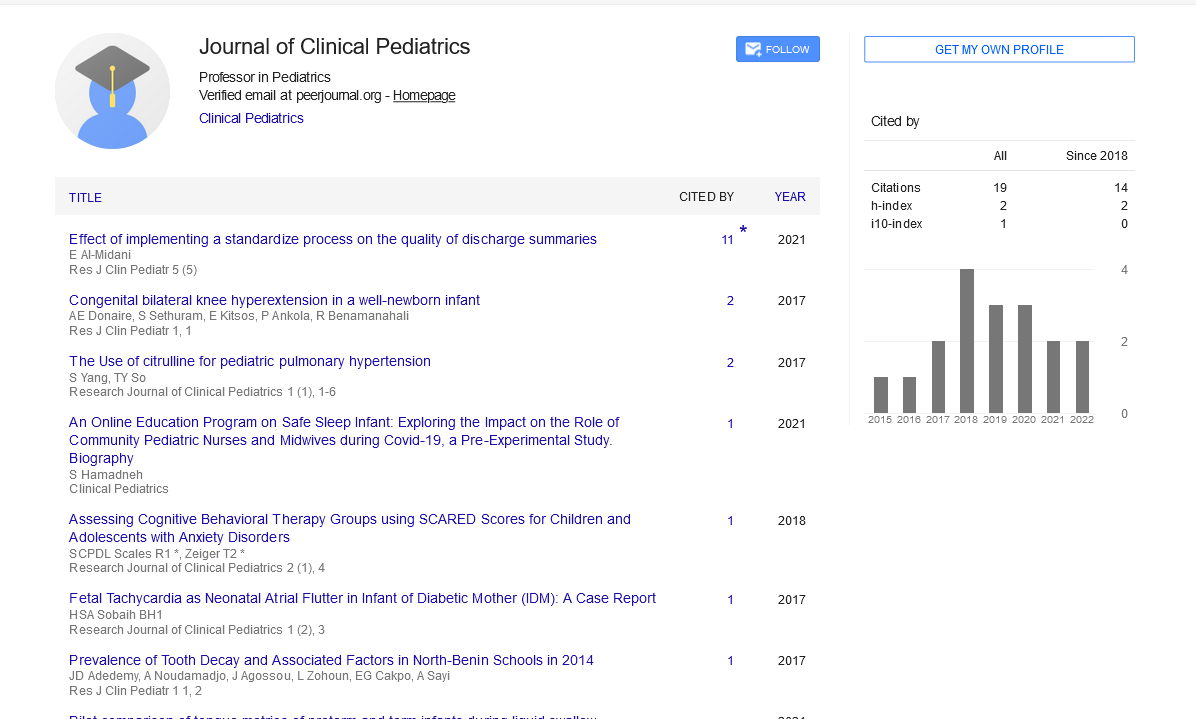Case Report, Res J Clin Pediatr Vol: 1 Issue: 1
Congenital Megaurethra
| Benslimane H*, Benmohamed N and Mallah N | |
| Department of Pediatric Urology, Medical School of Oran, Algeria | |
| Corresponding author : Benslimane H Department of Pediatric Urology, Medical School of Oran, Algeria E-mail: b.hammou76@yahoo.fr |
|
| Received: February 20, 2017 Accepted: April 11, 2017 Published: April 18, 2017 | |
| Citation: Benslimane H, Benmohamed N and Mallah N (2017) Congenital Megaurethra. Res J Clin Pediatr 1:1. |
Abstract
Mega-urethra congenital (MUC) or megalomaniac-urethra or macro-penis is a malformation of the male urethra characterized by an expansion of the latter has agenesis + or - extent of erectile bodies in the penis without detectable obstacle. Very few cases described it in the literature since the first description by Nesbit in 1955[1].
Keywords: Mega-urethra congenital; Megalomaniac-urethra; Macro-penis
Keywords |
|
| Mega-urethra congenital; Megalomaniac-urethra; Macro-penis | |
Introduction |
|
| Depending on the size of the erectile training deficit they are classified as: | |
| Total or partial agenesis of the spongy body = MU scaphoid. | |
| Agenesis of the spongy body + agenesis of the corpus cavernosum = MU Fusiform. | |
| It comes from a temporary blockage of the distal urethra in the fetus or defect mesenchymal affecting genito urinary tract [1,2]. The treatment is surgical. The prognosis depends on the associated malformations [3]. | |
Case Report |
|
| A newborn boy 28 days old admitted for urinary infection associated diarrhea (digestive table). | |
| Clinical examination: Penis macro inspection (large yard) showed 7 cm in length with one deflection and rotation. | |
| On palpation hypoplasia of the erectile bodies of the penis. Apical meatus, Testis up, No hypoplasia of the abdominal wall (Figure 1). | |
| Figure 1: Showing the findings of Radiological study. | |
| Besides the laboratory tests: urea, creatinine, blood count formula, ECB and urine were found incipient renal failure with UTI | |
| Ultrasound found bilateral ureterohydronephrosis with parenchymal index reduction observed right away, retrograde cystography urethrovaginal allowed us to classify the malformation and showed ureteral reflux vesicoureteral bilateral grade IV renal scintigraphy DTPA and DMSA was also conducted. | |
| Treatment | |
| The treatment is surgical, consists of: firstly a gesture of urinary diversion for the emergency nephrology (kidney failure) a type of palliative cystostomy was made which improved the urea and creatinine figures; associate a treatment of urinary infection antibiothérapie. The final gesture (second time) was performed at the age of 07 months by correcting distortion by the urethral urethroplasty according to a modeling technique NESBIT with urethral dissection bag reduction of the caliber of the urethra and resection of excess skin tissue. | |
| TRT MU scaphoid: The urethroplasty using the technique of Nesbit: | |
| Incision in the coronal sulcus | |
| Retraction of the sheath. | |
| Reduction of the caliber of the urethra with reconstitution of the latter on a probe charrière 08. | |
| Excess skin tissue is resecting with circumcision. | |
| The vesicostomy, having improved the condition of the kidney, was closed at the end of 08 months (one month the rough TRT MUC). The exterior was okay with normal urine flow (Figure 2a-2d). | |
| Figure 2: Aspect 7month old. 2b: Reduction of redundant urethra. 2c: Excision of redundant cutaneous tissue. 2d: Final aspect. | |
Discussion |
|
| Prenatal diagnosis is available at second trimester ultrasound can identify mesenchymal defect development (7th week) frequent association with Prune Belly Syndrome | |
| The often monstrous deformity of the penis with penile deviation attracts attention, from the neonatal period, making it easy diagnosis of this malformation. | |
| The radiological assessment is used to specify the type of the anomaly and its repercussion on the upper urinary tract and the existence of associated malformations are rare in cases of MUC scaphoid and often lethal if MUC fusiform. | |
| A bypass gesture is often necessary when there’s a severe impact upstream to decompress the upper urinary tract and improve progressive kidney failure while struggling against a urinary tract infection or on the warning. The correction of the urethral deformation is made as soon as possible and aims to raise the functional obstruction and strengthen the urethral wall. The technique of Nesbit and Locke seems to be the best in the forms by scaphoid against the treatment of forms fusiform remains very difficult some authors suggest the implantation of a penile prosthesis, other a sex change. | |
Conclusion |
|
| Congenital mega-urethra remains a very rare malformation that is often associated with other renal or other defects to look for. The surgical treatment depends on the anatomy of the latter type. Which is simpler in case of scaphoid type of mega-urethra. The prognosis depends mainly on the severity of associated malformations. | |
References |
|
|
|

